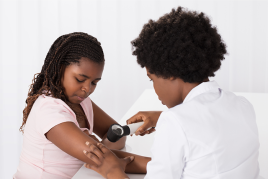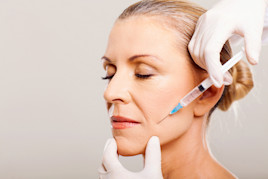Rosacea: Diagnosis and treatment
Thanks to research breakthroughs, many made by dermatologists, there are numerous rosacea treatments available today
A board-certified dermatologist can explain which ones may work best for you.

How do dermatologists diagnose rosacea?
A dermatologist diagnoses rosacea by examining your skin and eyes. Because signs of rosacea can come and go, your dermatologist will also ask you questions.
Sometimes, testing is necessary to rule out another condition like lupus, which can also cause a long-lasting color change to the face. And if you might have a rare type of rosacea called granulomatous rosacea, you may need a skin biopsy. This is a medical procedure that helps dermatologists diagnose many different skin conditions.
During a skin biopsy, your dermatologist removes a small amount of skin. This is done during an office visit while you remain awake. The removed skin is sent to a medical lab, where the skin will be looked at under a microscope.
Once your dermatologist has all the necessary information, you’ll get the diagnosis.
How do dermatologists treat rosacea?
If you have rosacea, your dermatologist will create a treatment plan tailored to your individual needs.
The goals of treatment are to:
Reduce (or eliminate) signs of rosacea.
Ease your discomfort.
Prevent rosacea from worsening.
When creating your treatment plan, your dermatologist will look for what triggers your rosacea flares. Common triggers include overheating, drinking alcohol, and eating spicy foods.
Your treatment plan will include tips to help you avoid what triggers your flare-ups, gentle skin care, and sun protection. When used along with medication, laser or light therapy, and other treatment as needed, this type of plan can help to control rosacea.
Skin care is an essential part of every rosacea treatment plan
In your treatment plan, your dermatologist will include a gentle cleanser, moisturizer, and sunscreen. Using these as directed will allow you to get the most out of treatment
Medication and other therapies that treat rosacea
Here are treatments that your dermatologist may include to treat the following signs and symptoms of rosacea.
Redness: A treatment called intense pulsed light therapy can reduce flushing and improve your skin’s texture. This treatment is gentler on the skin than a laser. It also requires more treatment sessions than laser therapy.
Medication is another treatment option. Your dermatologist may prescribe one that can reduce flushing.
Persistent (long-lasting) color on your face: When the color stays on your face, your dermatologist may prescribe one of the following FDA-approved medications:
Brimonidine gel or oxymetazoline cream: Both of these medications can fade the persistent color for up to 12 hours. The medications work by narrowing the blood vessels under the skin, which temporarily reduces flushing and long-lasting color changes on the skin.
Patients apply this medication daily or as needed to their face. Most patients see their best results 3 to 6 hours after applying the medication. After that, the persistent color gradually returns.
Although the color returns, you can use this medication every day. Applying this medication daily for a year or longer may help reduce the intensity of the color, so you see less overall discoloration.
Both medications are FDA approved to treat persistent (ongoing) facial redness in people 18 years of age and older who have rosacea.Brand names: Mirvaso (brimonidine gel), Rhofade (oxymetazoline cream)
Laser therapy: The right laser can effectively reduce the red or pink (lighter skin tones) or the violet or brown (darker skin tones) color changes that can occur.
When treating persistent color, the goal is to return your skin tone to its pre-rosacea color.
Acne-like breakouts: A medication that you apply to your skin (topical) is often effective for treating acne-like breakouts. When using topical medication, you may see a slight improvement in 3 or 4 weeks. It usually takes 2 to 3 months to see a noticeable difference.
If topical treatment doesn’t work or you need stronger treatment, an oral (take by mouth) antibiotic may be part of your treatment plan.
The FDA has approved the following medications to treat the acne-like breakouts of rosacea:
Azelaic acid (foam or gel): This medication can effectively treat acne-like breakouts and may reduce long-lasting color. You apply this medication twice a day after cleansing with the gentle cleanser that your dermatologist recommends. Once the medication dries, you can apply makeup.
Brand name: Finacea
Encapsulated benzoyl peroxide cream 5%: Benzoyl peroxide can irritate sensitive skin, making it an unacceptable treatment for rosacea. This medication changes that. A technology called microencapsulation gradually releases benzoyl peroxide, making it a treatment option for acne-like breakouts.
You apply this cream as directed, usually once a day. When using this medication, you may notice that your skin is more sensitive to sunlight and artificial light. Using a tinted sunscreen that offers broad-spectrum protection, SPF 30 or higher, and water resistance can help protect your skin.Brand name: Epsolay
Ivermectin cream: This medication reduces inflammation and is used to treat inflammatory acne-like breakouts. It’s usually applied once a day.
Brand name: Soolantra
Metronidazole (cream, gel, or lotion): This is an antibiotic that you apply to your skin. It can effectively treat acne-like breakouts, long-lasting color, and bacteria on your skin. Your dermatologist will tell you how often to apply the medication, usually once or twice a day. Use it exactly as directed, along with the other products in your treatment plan like a gentle cleanser and sunscreen.
Brand names: MetroCream, MetroGel, MetroLotion, Noritate, Rosadan, Rozex, Vitazol
Minocycline foam: This foam contains the antibiotic minocycline, which is used to treat inflammatory acne-like breakouts in adults.
Brand names: Amzeeq, Zilxi
Low-dose doxycycline (oral): Doxycycline is an antibiotic; however, this medication contains such a low dose that the medication works to reduce inflammation. Since it’s a non-antibiotic dose, the medication can be used long term.
Patients take one pill a day to control acne-like breakouts.Brand name: Oracea
Occasionally, your dermatologist may prescribe one of the following medications:
Sulfacetamide and sulfur lotion: This medication combines an antibiotic with sulfur, which can remove the top layer of skin. It can treat rosacea’s acne-like breakouts. If you also have a skin condition called seborrheic dermatitis, this may be an effective treatment for both conditions.
Use this medication exactly as directed. If the rosacea worsens or you develop a rash, stop using the medication and contact your dermatologist right away.Brand names: Avar, Plexion, SulfaCleanse, Sumadan
Antibiotic: When a non-antibiotic dose of doxycycline or another medication cannot reduce the acne-like breakouts and intense long-standing color, an antibiotic can be effective. When this medication is needed, a dermatologist prescribes the antibiotic for the shortest amount of time possible.
 Visible spider veins
Visible spider veins
Before (left) and after (right) two laser treatments for persistent redness and visible veins.
Visible blood vessels: If you wish to treat the visible blood vessels on your face, tell your dermatologist. Treatment is available. Your dermatologist may recommend:
Laser or light treatments
A procedure called electrodesiccation, which uses small electric needles to diminish the veins.
These procedures can be highly effective when performed by a dermatologist who is skilled in using the procedure to treat visible blood vessels.
In inexperienced hands, laser therapy, light treatments, or electrodesiccation can be dangerous. Burns, permanent changes to your skin color, or scars can occur. You can greatly reduce the risk of possible side effects by having your treatment performed by a medical doctor who is extremely skilled in using the procedure and has in-depth knowledge of the skin. The AAD recommends that you choose a board-certified dermatologist to perform your procedure.
Treatment for the eyes (ocular rosacea): When rosacea affects your eyes, treatment is essential. If the ocular rosacea is mild or moderate, your dermatologist may treat it or refer you to an eye doctor (ophthalmologist) for treatment. Anyone with ocular rosacea that threatens their eyesight is immediately referred to an ophthalmologist.
If your dermatologist treats you, your treatment will include one or more of the following:
Warm compresses and eyelid hygiene: This can reduce symptoms. It’s usually done twice a day at home.
The first step is to apply a warm compress, leaving it on your eyes for as long as your dermatologist recommends. Afterward, you cleanse your eyelashes with baby shampoo or a wet washcloth that you gently rub on your eyelashes, while your eyes are closed. Your dermatologist will explain how to do this and tell you how long you need to do it.Omega-3 fatty acids: This is a supplement that you take. It can reduce dryness. Your dermatologist will tell you how often to take this supplement.
Artificial tears: Ocular rosacea can make eyes very dry. They may feel gritty.
Antibiotic eye treatment: You apply this to your eyes to decrease the bacteria and soften any debris on your eyelashes called “collarettes.” Softening the debris can make it easier to remove them from your eyelashes during eyelid hygiene.
Be sure to use the antibiotic that your dermatologist prescribes
Not every antibiotic is safe for use on your eyes. Antibiotics made for the skin can be harmful when used to treat the eyes.
Cyclosporine eyedrops: Used twice a day, these drops can relieve symptoms like burning, stinging, and light sensitivity. The drops can also treat signs of ocular rosacea on the eyelids like redness and swelling.
Brand name: Restasis
Intense pulsed light (IPL): Often used to treat persistent color on the face and other signs of rosacea, IPL can help with eyes, too. In experienced hands, IPL can ease signs and symptoms of ocular rosacea.
Oral medication: To control inflammation, your dermatologist may prescribe low-dose doxycycline (dose too low to be an antibiotic) or an antibiotic.
Thickening skin: If you’re diagnosed with rosacea, pay attention to your skin. If you notice firm, round bumps or thickening of the skin on your face, it’s time to see a dermatologist. These changes are most common on the nose. You may also notice them on your chin, forehead, eyelids, or one or both ears.
The medical term for these changes is ”phyma” (fie-ma). When thickening skin develops on the nose, it’s called rhinophyma.
The earlier phyma is diagnosed and treated, the better. Your dermatologist may be able to treat it with medication if caught early enough. The more the skin thickens, the more difficult treatment becomes.
Allowed to progress, phyma can also cause medical problems. When it affects the nose, you may have trouble breathing. Swollen, thick eyelids can affect your vision.
To prevent thickened skin from growing thicker, you dermatologist may prescribe:
Doxycycline: This is an antibiotic that can prevent skin from further thickening. Your dermatologist may prescribe low-dose doxycycline. The dose is too low to be an antibiotic, which means the medication can be used long term.
Brand name: Oracea
Isotretinoin: Approved to treat severe acne, this medication can also prevent thickening skin from growing thicker. Isotretinoin cannot get rid of the existing thickened skin. You’ll need a procedure for that.
Because isotretinoin can cause serious side effects, this medication is not a treatment option for everyone. You can learn more about potential side effects at, Isotretinoin: The truth about side effects.Brand names: Absorica, Absorica LD, Amnesteem, Claravis, Myorisan, Sotret, Zenatane
To remove thickened skin and contour the area, your dermatologist may recommend one of the following procedures:
Surgical removal: Your dermatologic surgeon will use surgical instruments like a scalpel to surgically remove excess tissue and sculpt the area.
Laser surgery: Uses light to remove excess tissue and sculpt the area.
Radiofrequency: Heats the area to remove excess tissue and sculpt.
Electrosurgery: Uses electric current to heat the excess tissue, allowing it to be cut with greater precision.
Choosing a board-certified dermatologist or dermatologic surgeon who has experience surgically treating the thickening skin of rosacea can help prevent complications.
Follow a maintenance treatment plan
Once rosacea is under control, your dermatologist may switch you to a maintenance treatment plan. This can help you maintain your results and often requires using a single treatment.
To get the best results from your original treatment plan and maintain those results, skin care, sun protection, and trigger management are essential. To see the skin care that dermatologists recommend, go to 7 rosacea skin care tips dermatologists recommend.
Images
Image 1: Getty Images
Image 2: Used with permission of the Journal of the American Academy of Dermatology. (J Am Acad Dermatol 2004;51:592-9.)
References
Bhargava R, Chandra M, et al. “A randomized controlled trial of omega 3 fatty acids in rosacea patients with dry eye symptoms.” Curr Eye Res. 2016 Oct;41(10):1274-80.
Bhatia ND, Werschler WP, et al. “Efficacy and safety of microencapsulated benzoyl peroxide cream, 5%, in rosacea: Results from two phase III, randomized, vehicle-controlled trials.” J Clin Aesthet Dermatol. 2023 Aug;16(8):34-40.
Cices A, Alexis AF.” Patient-focused solutions in rosacea management: Treatment challenges in special patient groups.” J Drugs Dermatol. 2019 Jul 1;18(7):608-12.
Del Rosso JQ, Brantman S, et al. “Long-term inflammatory rosacea management with subantibiotic dose oral doxycycline 40 mg modified-release capsules once daily.” Dermatol Ther. 2022 Jan;35(1):e15180.
Dick MK, Patel BC. “Rhinophyma.” [Last updated 2023 Aug 8]. In: StatPearls [Internet]. Treasure Island (FL): StatPearls Publishing.
Draelos ZD, Gold MH, et al. “Efficacy and safety of oxymetazoline cream 1.0% for treatment of persistent facial erythema associated with rosacea: Findings from the 52-week open label REVEAL trial.” J Am Acad Dermatol. 2018 Jun;78(6):1156-63.
Gupta M, Singh G, et al. “Severe rhinophyma treated by shave excision and electrocautery.” BMJ Case Rep. 2020 Jan 13;13(1):e232973.
López-Valverde G, Garcia-Martin E, et al. “Therapeutical management for ocular rosacea. Case Rep Ophthalmol. 2016 May 2;7(1):237-42.
Nagler AR, Del Rosso J. “The use of oral antibiotics in the management of rosacea.” J Drugs Dermatol. 2019 Jun 1;18(6):506.
Kassir R, Kolluru A, et al. “Intense pulsed light for the treatment of rosacea and telangiectasias.” J Cosmet Laser Ther. 2011 Oct;13(5):216-22.
Package inserts for Mirvaso, Finacea, Soolantra
Raedler LA. “Soolantra (ivermectin) 1% cream: A novel, antibiotic-free agent approved for the treatment of patients with rosacea.” Am Health Drug Benefits. 2015 Mar;8(Spec Feature):122-5.
Sharma A, Kroumpouzos G, et al. “Rosacea management: A comprehensive review.” J Cosmet Dermatol. 2022 May;21(5):1895-1904.
Thiboutot D, Anderson R, et al. “Standard management options for rosacea: The 2019 update by the National Rosacea Society Expert Committee.” J Am Acad Dermatol. 2020 Jun;82(6):1501-10.
Written by:
Paula Ludmann, MS
Reviewed by:
Elan M. Newman, MD, FAAD
Rajiv I. Nijhawan, MD, FAAD
Brittany Oliver, MD, FAAD
Last updated: 4/3/24
 Molluscum contagiosum: How to safely treat it
Molluscum contagiosum: How to safely treat it
 Biosimilars: 14 FAQs
Biosimilars: 14 FAQs
 Practice Safe Sun
Practice Safe Sun
 Relieve uncontrollably itchy skin
Relieve uncontrollably itchy skin
 Fade dark spots
Fade dark spots
 Untreatable razor bumps or acne?
Untreatable razor bumps or acne?
 Laser hair removal
Laser hair removal
 Scar treatment
Scar treatment
 Botox
Botox
 Free materials to help raise skin cancer awareness
Free materials to help raise skin cancer awareness
 Dermatologist-approved lesson plans, activities you can use
Dermatologist-approved lesson plans, activities you can use
 Find a Dermatologist
Find a Dermatologist
 What is a dermatologist?
What is a dermatologist?